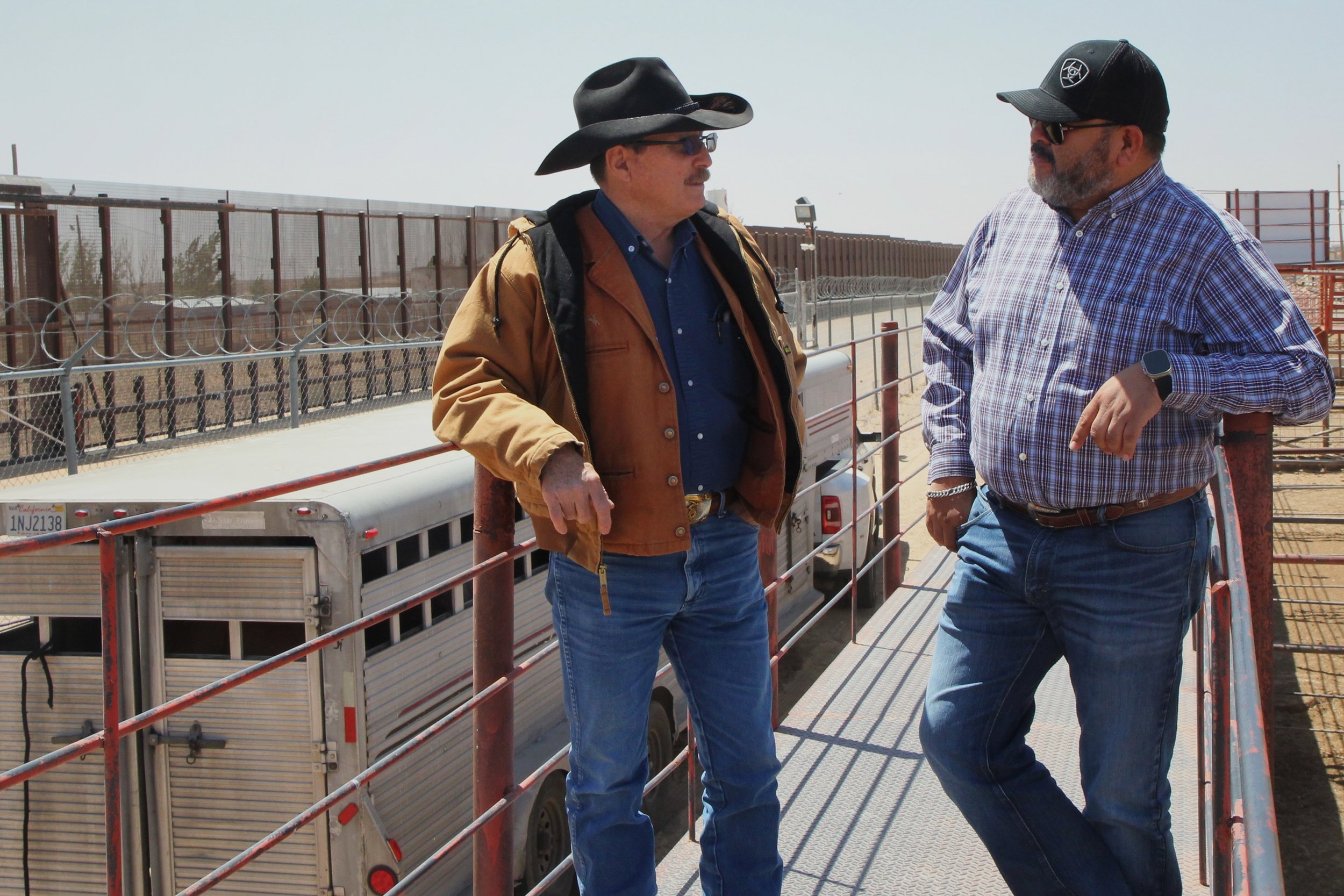For borderland cattle ranchers, a trade war with Mexico adds to the list of troubles
A worker at the Unión Ganadera Regional de Chihuahua on the U.S.-Mexico border guides newly arrived cattle into the proper pen. Photo by Sandra Sadek for Puente News Collaborative
Could sirloin steak and burger prices rise even higher?
Editor’s note: This story was produced for Puente News Collaborative in partnership with the Craig Newmark Graduate School of Journalism at the City University of New York (CUNY).
SANTA TERESA, N.M. — Bandanas veiled ranchers’ mouths and noses, shielding them from heavy dust clouds kicked up by the Mexican herds of cattle crossing the United States-Mexico border.
The scene looks routine, timeless. The uncertainty isn’t.
In Donald Trump’s first 100 days, the borderland’s cattle industry faces a huge challenge: threats of a trade war already hitting consumers in the gut with rising beef prices, from Texas to New York, to California. The on-again-off-again tariff impositions and worries in February and March jolted Mexican cattle producers with mounting economic losses.
“The tariffs, it's a game killer,” said Daniel Manzanares, director of Unión Ganadera Regional de Chihuahua, the Regional Livestock Union of Chihuahua.
The unpredictability of Trump’s tariff policy on Mexico earlier this year has already cost ranchers millions of dollars in profit losses, according to Manzanares.
“It was horrible …” he said. “They're trying to get that money back, but I doubt they'll ever be able to.”
Daniel Manzanares, left, director of Unión Ganadera Regional de Chihuahua, and Marco Herrera, a U.S. customs broker with private agency Capin-Vyborny, discuss cattle border crossings at the port of entry in Santa Teresa, N.M., on April 15, 2025. Photo by Gibran Caroline Boyce for Puente News Collaborative
Recently, most of the 1,300 cattle moved north that day for fattening in feed pens before final transformation into steak, burgers, and meatballs for U.S. consumers. But that could soon end.
Free trade agreements protect around half of all goods coming from Mexico into the U.S., including beef. But for many in the industry, the uncertainty surrounding federal U.S. policies has ranchers spooked.
“It doesn't really matter at this point in terms of what the exemptions even are,” said Alex Durante, senior economist at the D.C.-based think tank Tax Foundation. The Trump administration “has been behaving so erratically that it's in general very difficult for businesses to invest in this environment.”
Cattle imports from Mexico’s sprawling border state of Chihuahua remain crucial to the U.S. livestock economy, especially with a U.S. beef shortage and the highest-ever beef prices, say ranchers here from Unión Ganadera.
The cost of maintaining one of the nation’s most vital industries had already become precarious. A parasitic screwworm outbreak, a devastating drought, and personnel shortages at U.S. ports of entry already plagued the system.
While Trump’s trade policy continues to evolve, his administration’s break with decades of American free trade policy threatens to unravel a long-established system of cross-border trade that’s embedded in the very name of El Paso del Norte — the Pass of the North.
Thousands of cattle from San Jerónimo, Mexico, enter the U.S. at the Santa Teresa Border Crossing in New Mexico, where they will be fattened at feedpens across the country before being slaughtered for U.S. consumption. Photo by Sandra Sadek for Puente News Collaborative
Manufactured Chaos at the Border
The tariff chaos in Mexico in early February and March provided a glimpse into the potential collapse of U.S.-Mexico free trade.
On Feb. 1, Trump announced a 25% tariff on all goods from Mexico. In February alone, the tariff scare (along with a preceding pest outbreak) caused $3 million in losses for ranchers, said Alvaro Bustillos, president of Vaquero Trading in Santa Teresa.
Those same tariffs were paused in March before being reinstated on April 2 for “Liberation Day.” One week after Trump’s April announcement, tariffs on Mexican goods were paused once again, further adding to the unpredictability of U.S. economic policy.
Marco Herrera, a U.S. customs broker with private agency Capin-Vyborny, and his team are responsible for issuing documents for imports and ensuring buyers and sellers comply with tariff regulations. The Trump administration’s tariff announcement in February sent panic through border industries and stalled cattle crossings.
Daniel Manzanares, director of the Unión Ganadera Regional de Chihuahua, shows the list of cattle entering the U.S. from Mexico on April 15, 2025, at the Santa Teresa Border Crossing. Photo by Sandra Sadek for Puente News Collaborative
After Trump announced the tariffs, customs brokers, buyers, and sellers were unprepared to implement them with only 48 hours' notice, Herrera said. He abruptly drove 10 hours back from California to New Mexico after first hearing about it on social media. He said the White House did not share in advance any formal guidance on which products would be affected.
“The sellers and buyers didn’t understand who was responsible for paying the tariffs,” Herrera said. “The buyer was telling the seller, ‘You’re responsible.’ The seller was telling the buyer, ‘You’re responsible.’ Under U.S. customs law, the responsible party is the buyer. The consumer in the US is who will absorb the costs.”
As U.S. consumers slowly begin to feel the costs, the first victims are cattle ranchers in Mexico. The $600 million-plus industry is the third-largest economic pillar in Chihuahua. Across the border, New Mexico processes nearly a third of all cattle imported from Mexico annually.
Over 90% of cattle producers with the Unión Ganadera Regional de Chihuahua are small ranchers who have around 10 to 15 cattle available for the entire year.
Carlos Fernández, one of the pen riders at Unión Ganadera Regional de Chihuahua. Photo by Gibran Caroline Boyce for Puente News Collaborative
Meat prices in the U.S. have been steadily increasing over the years. Data from the U.S. Department of Agriculture shows prices for sirloin steak in the U.S. increased from a little over $10 per pound in March 2023 to nearly $12 per pound in March 2025. During that same period, ground beef prices rose from almost $5 per pound to almost $6 per pound.
The threat of tariffs against Mexico has alarmed some ranchers who fear losing money if they send cattle across the border, despite some protections for certain goods under the U.S.-Mexico-Canada Agreement (USMCA), including livestock. Implemented in 2020 during the first Trump administration, the USMCA replaced the North American Free Trade Agreement (NAFTA).
Manzanares said many ranchers have already “canceled their border crossing date,” because they “didn’t want to take a chance of having $500 a head taken away.” He said hundreds of dollars were lost per cattle after tariffs went into effect. “It's a damn outright steal,” he said referring to the tariffs.
Trump is pushing high import taxes as his solution to boosting U.S. industries and protecting U.S. jobs. The move, Herrera said, will instead end up directly hurting agricultural workers and U.S. consumers.
“With 25% tariffs, Mexican producers are no longer going to want to do business through U.S. ports of entry,” said Herrera on the tariff chaos in February. “Instead of making money, we’re losing money… We’re going to lose our jobs. There's not going to be enough cattle for all the U.S. customs brokers, the buyers, the transportation companies.”
Amid these growing fears, in February and March, Trump issued pauses. Following March’s 30-day reprieve, he announced on April 2 an additional 10% baseline tariff on all goods imported into the country, as well as reciprocal tariffs on countries with trade surpluses with the U.S. The reciprocal tariffs remain paused for 90 days, but the 10% tax still stands.
Cattle from all over the Mexican state of Chihuahua enter the U.S. at the Santa Teresa - San Jerónimo Border Crossing in New Mexico. Photo by Sandra Sadek for Puente News Collaborative
An Environmental Crisis
Tariffs are just the latest setback for border ranchers. Even before the trade war, a prolonged drought, rising inflation, and a screwworm parasite outbreak disrupted much of the cattle industry along the U.S.-Mexico border.
Bustillo calls it “the most complicated times” the Chihuahua cattle industry has ever faced.
Support the voices of independent journalists.
|
The northern part of Mexico has had a drought since late 2022, affecting 76% of the country, roughly 98 million people. The resulting diminished forage is forcing many ranchers to purchase more feed, raising the costs of maintaining their herds of cattle. This has shrunk the producers’ herds, many of whom are already smaller ranchers.
The outbreak of a parasitic fly pest known as the “New World screwworm’’ exacerbated the ranchers’ plight.
The screwworm lives off the flesh of living mammals. Usually found in Central America, the parasite made its way to Mexico in late 2024, despite efforts by the local authorities to contain it. The cattle cross-border trade between the U.S. and Mexico was completely shut down between November and December due to the outbreak.
Newly arrived cattle from Chihuahua are herded into a pen after crossing the U.S.-Mexico border in Santa Teresa, New Mexico, on April 15, 2025. Photo by Gibran Caroline Boyce for Puente News Collaborative
As a result, Mexican cattle ranchers implemented more sanitary measures to meet new U.S. Department of Agriculture (USDA) requirements to continue bringing their cattle north. All USDA inspections must now be completed on Mexican soil, which means only five of the original 12 ports are active at this time.
Additionally, according to Herrera, mass firings at the USDA by Elon Musk’s so-called Department of Government Efficiency (DOGE), accompanied by an indefinite hiring freeze of specialized inspectors and technicians, have kept ports of entry shuttered to cattle crossings. This includes one in the neighboring border town of Columbus, N.M., because of a lack of personnel to perform the inspections.
At remaining ports, like the one in Santa Teresa, Bustillos of Vaquero Trading, said inspection bottlenecks continue.
“All these [Mexican] states want to come through our crossing ports, and we only have limited capacity to get [the herds] across,” Bustillos said. “We're working at 50% capacity now.”
Alvaro Bustillos, president of Vaquero Trading in Santa Teresa, said the threat of tariffs is the latest factor economically hurting cattle ranchers along the southern U.S. border, after a drought and parasitic outbreak reduced the size of herds. Photo by Sandra Sadek for Puente News Collaborative
With months of border closures and tightened cattle inspections, any further hurdles, like tariffs, threaten to compound already stark losses.
“We have the door to the best market in the world, one that pays the highest premiums,” Bustillos said. “I don't think there's a place in the whole world that has the prices of steaks or beef like the United States has. [The U.S.] brings a lot of value to the industry.”
That open door to the world’s best beef market may not remain open much longer.
“It's a downright shame what's happening,” Manzanares added. “Our best friends are Canada to the North, Mexico to the South. It does not bode well for us on a global level for trade.”
—
Sandra Sadek is a freelance journalist based in New York. She is studying international reporting at the Craig Newmark Graduate School of Journalism at the City University of New York (CUNY). Previously, she was a Report for America Corps Member in North Texas. Her work has appeared on the Fort Worth Report and KERA News. She will be interning this summer at EVN Report in Yerevan, Armenia. @ssadek19
Gibran Caroline Boyce is a freelance journalist based in New York City, pursuing a master’s degree in international reporting at the Craig Newmark Graduate School of Journalism at CUNY. She will soon join EVN Report in Yerevan, Armenia, as an intern covering international security and geopolitics. She previously worked as a production intern at CNN on Fareed Zakaria GPS and holds a bachelor’s degree from Boston College in international studies, with a focus on cooperation and conflict. @gibranboyce
Dianne Solis is a freelance journalist. She has worked as a staff writer for The Dallas Morning News and The Wall Street Journal. Her work has aired on KERA public radio and the Texas Standard. She has reported extensively on immigration for decades. She graduated from Northwestern and California State University and was a Nieman Fellow at Harvard. @disolis
Alfredo Corchado is the executive editor for Puente News Collaborative and the former Mexico/Border Correspondent for The Dallas Morning News. He’s the author of “Midnight in Mexico” and “Homelands.” @ajcorchado


















